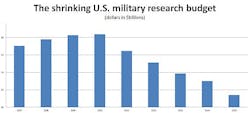Military research spending continues to trend down; when do we risk a budget cut too far?
A 10-year analysis of the DOD's annual requests for research, development, test, and evaluation (RDT&E) shows the Pentagon's planned spending for priority military technology research has fallen 21.5 percent since its 2010 peak during the past decade.
The Pentagon's RDT&E request in 2010 was for $80.92 billion. Since then military research requests have diminished every year, and for fiscal 2015, which begins next Oct. 1, U.S. military leaders have asked for just $63.55 billion.
That's the lowest technology research request the Pentagon has made in the last decade. We should ask ourselves, is this the right thing to do?
Related: Military technology research and development set to continue three-year decline in 2013
Okay, I know that sixty-three and a half billion dollars is a lot of money by any measure. Still, is it sufficient to cover U.S. military technology needs over the next decade or so, amid a world political scene that is descending into turmoil in the Middle East, the Western Pacific, and most lately in the Ukraine, Eastern Europe, and other regions.
Is the technology developed in commercial industry sufficient to meet growing military needs? Perhaps it is; maybe I'm just being alarmist. Still, I see the downward trend in the nation's military research budget over the past five years and I'm not reassured.
Don't get me wrong, commercial technology is great, and it's getting better. Electronics miniaturization, high levels of electronics integration, high-performance embedded computing (HPEC), digital communications and networking, and the like are far more advanced than they've ever been.
Still I'm concerned, because if it's commercial technology, then it's available to everyone, friend and potential foe alike. I reckon that more often than not it's the U.S. military RDT&E budget that drives the unique technology development that's necessary to keep our fighting forces on the technological leading edge.
Related: International suspicions of U.S. encryption technology putting defense companies in a bind
Let the military research budget atrophy, and bad things can happen. Our nation's potential adversaries -- particularly Russia and China -- are increasing their defense budgets, and historically have shown themselves to be more than willing to copy whatever useful military technology that comes their way.
It's simply not enough to maintain the status-quo in these tumultuous times. The size of U.S military forces is shrinking, with force reductions planned, weapon systems slated for retirement, and more U.S. and overseas military base closures on the horizon.
What shouldn't shrink is the high level of U.S. military technology, and the size of the DOD's research budget is a direct measure of our nation's resolve to remain on the technological leading edge. Once lost, that edge is difficult, expensive, and time-consuming to get back.
In today's global economy it might not even be possible. We should think about that before passively watching the Pentagon's RDT&E budget shrink any farther.

